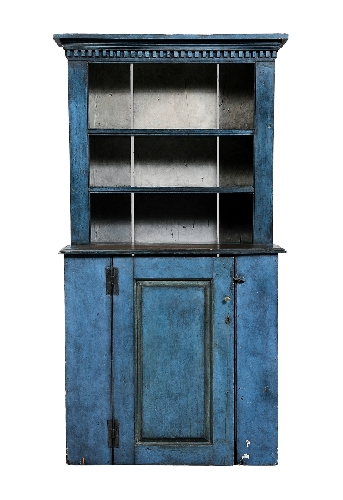Cupboards grew with need to store more things

Where to put clutter? How to store extra dishes or clothes or memorabilia? These are questions that have been asked only since the beginning of the 20th century. Before that, storage was a very different problem.
For most families, their textiles were their most valuable possessions and were just about the only thing that needed to be stored. The family had to shear the sheep, then clean, card and dye the wool, then make the thread and weave it into fabric. Hundreds of hours of handwork were needed to make a dress or a coverlet, and the family had few spares. Rooms were small, and furniture was placed out of the way. A single cupboard might be put against a wall or built into a corner. Cupboard tops had open shelves to hold dishes, glasses and pots. Bottom sections had shelves behind closed doors to keep fabrics clean and free of smoke. In the bedroom area, there might be a tall cabinet or cupboard with large drawers for clothing and bedclothes.
By Victorian times, houses were being built with a few storage areas, even closets. And by the 1900s, people started wanting cupboards in their kitchens.
Country furniture is popular today, and its simple, informal lines fit in modern houses. Country cupboards were often painted and had just a top molding and perhaps some door trim. Drawer and door pulls were wooden knobs, and hardware was made of iron.
Collectors today pay a premium for pieces with original painted finish and original parts, including the back panels. Look carefully for replaced wooden parts, especially the feet or bottom board. Cupboard bottoms were splashed with water when the floor was cleaned and they often decayed. Examine everything else, too. It is easy to make a fake or a “marriage.”
A good corner cupboard with attractive worn paint, even with replaced parts, sells for $1,000 or more. A complete cupboard with rich finished wood and trim can cost about $3,000 to $5,000.
Q: My small teapot is marked “Imperial Crown China, Austria.” What can you tell me about it?
A: The “Imperial Crown China” mark was used from about 1884 to 1914 by Bawo & Dotter, a New York importing company that sold china made in France and Austria-Hungary. It also owned a china decorating company in Fischern, now in the Czech Republic. The company may also have manufactured china in Fischern.
Q: My great-aunt gave me a cat-head pin in 1969. I still have it. It’s gold-plated or gold-tone metal with wire whiskers that stick out the sides of the face. The cat’s ears are decorated with red rhinestones. The pin is marked “Joseph Warner” on the back. Have you heard of him?
A: Your great-aunt gave you a very good piece of costume jewelry. Joseph Warner’s Warner Co. started making costume jewelry in about 1953 and closed some time in the 1970s. Not all Warner pieces are marked, and some pieces are simply marked “Warner.” Warner jewelry is well-made and popular.
Your pin could sell for $50 or more.
Terry Kovel’s column is syndicated by King Features. Write to: Kovels, (Las Vegas Review-Journal), King Features Syndicate, 300 W. 57th St., New York, NY 10019.












